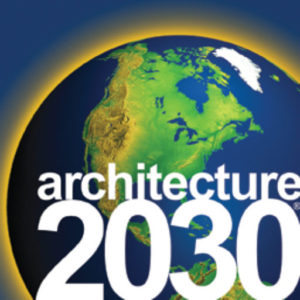A Historic Moment
(Excerpt from the article “Beauty and the Beast”, by Ed Mazria which appeared in the April 2006 Issue of Design Intelligence Magazine.)
Throughout most of the twentieth century, contemporary global architecture has been characterized by a reliance on seemingly inexpensive fossil-fuel powered “active” technology to the exclusion of other factors. We are currently dependent on the mechanical control of sealed indoor environments, rather than the designed exploitation of climatic and other natural processes, to satisfy our comfort requirements. As a result, today we can see the same basic building type in all climatic regions throughout the world. And so we have become prisoners of complicated mechanical systems, since a minor power or equipment failure, or fossil fuel delivery disruption, can make many contemporary buildings uninhabitable.
Historically, significant transformations in building design and planning have always followed great world events, and as such serve as a record of the times. In some instances, as with the Industrial Revolution and the grand engineering structures that followed, architecture has reluctantly held on to the past until pushed into the present. There is always a concept, a spark, a significant event that ignites the profession and seems to turn it in another direction, grab its attention. We are, I believe, at one of these moments. Never before in human history has the earth been so threatened, and never before has the design community been challenged to lead the world in a new direction, helping it avert large scale dislocations and setting the tone for international cooperation as we struggle to stem the tide of global warming.
We have all heard the arguments surrounding climate change, from impending doom and draconian GHG reduction measures at one end of the spectrum to the destruction of the global economy and the characterization of global warming as fiction, at the other end. Each extreme cites only the information that suits its cause and ignores the rest. Nevertheless, the latest scientific data recently published confirms that we do have a serious global warming problem, that it is human-caused and that we humans must now take reasonable measures to address the situation. The studies I draw your attention to include:
- June 2, 2005, Scripps Institute of Oceanography, “Scripps-led Global Ocean Warming Research Paper Published in Science”.
- February 16, 2006, NASA, “Greenland Ice Loss Doubles in Past Decade, Raising Sea Level Faster”.
- March 2, 2006, NASA, “NASA Mission Detects Significant Antarctic Ice Mass Loss”.
- March 30, 2006, British Antarctic Survey, “Rapid Temperature Increases above Antarctic”.
The “2030 Challenge” clearly outlines a global strategy to immediately stabilize and begin reducing building sector GHG emissions, with the goal of realizing a 60% to 80% reduction below today’s level by 2050. What makes this strategy unique is that it is mostly achievable through design, through creative problem solving and the application of information and innovation, the very elements that are the foundation of the design professions.
There is no short-term or long-term GHG reduction solution possible without involving the global design community. To date, this community has not been invited to participate in meetings, policy setting sessions or UN and IPCC (Intergovernmental Panel on Climate Change) gatherings regarding climate change. This illustrates that the scientific community, government and general public do not really understand what architects, planners and designers do and how central their role is in crafting meaningful mitigation strategies. With time running short, and abrupt rather than gradual climate change looming as a distinct possibility, the design community must be quickly engaged.

